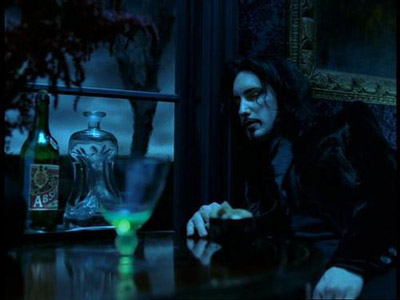Trent Reznor & Erik Satie: Majestic Angst-Bros of Minor Key Minimalism
Editor’s Note: This gem of a submission from writer/proto-ambient scholar/fervent NIN-lover Matt Keefer was discovered several tiers deep during a recent trawl of the Coilhouse slush account. It’s an offbeat and spirited piece, simultaneously comparing and cross-referencing the musical and philosophical kinship inherent between Erik Satie and Trent Reznor, and issuing several preemptive strikes against any and all Would-Be Jaded Hipster Remonstrators. (Also, somehow, on a profound level, it feels like the perfect blog follow-up to that horrifying “Keyboard Cat In Hell” clip Ross just posted). Thank you, Matt. Keep on angstin’ on, comrades.
Trent Reznor is the rightful successor to the great Erik Satie. Don’t let yourself ignore this plain and obvious fact because you are embarrassed of your youth. And no, Trent isn’t disqualified from this lofty inheritance by his perpetual unhappiness. Satie had it just as bad.
In the Spring of 1893, the ever-eccentric Monsieur Erik began a torrid affair with the artist and model Suzanne Valadon. An odd duck in her own right, Madame Valadon kept a goat at her studio to gobble up any of her work that she was unhappy with. After only a single night with Valadon, Erik proposed; the marriage never happened (or if it did, the records of such were later eaten by said goat), but Valadon did move to the room next to Satie’s at the Rue Cortot in Paris. Satie became increasingly obsessed with Valadon, often referring to her as his nanny-goat and filling notebooks with worshipful scrawlings about “her whole being, lovely eyes, gentle hands, and tiny feet.” Indeed, Satie composed his Danses Gothiques as a calmative to restore his composure in the face of the amorous frenzies that Valadon inspired in him. In turn, Valadon painted a portrait of Satie and gifted it to him:

Portrait of Erik Satie by Suzanne Valadon. Who can resist the Pince-Nez? WHO?
Sadly, six months later, the affair ended. One chilly winter evening Valadon vanished, leaving Satie with only his portrait and a broken heart to remember her by. Satie snapped, scrawling in the latter pages of his journals that nothing remained for him “but an icy loneliness that fills the head with emptiness and the heart with sadness.” This is the only intimate relationship that Satie ever had. He would later move to a room in Arcueil and in the 27 years before he drank himself to death, there is no record of anyone visiting his room.
Trent Reznor and Erik Satie are two angst-brothers who can fuck your shit up with nothing but a minor key and a couple of quarter notes. This fact makes it a little difficult to find good YouTube recordings of Erik Satie, since every weirdo jackass in the world (including me) can play either Gnossiennes or Gymnopedies. It takes virtually no technical skill to play these – only a sense of musicality. Satie’s works are the great equalizers for pianists who obsess over technical skill at the expense of poetic ability. Today, that same simplicity gets Reznor blown off as untalented and musically immature, while it often renders Satie all the honors of every academy.

The Trent and Erik Awesome Show, GREAT JOB!
I get it, I get it. You liked Nine Inch Nails as a kid and now that you’re all grown up and super-hip, you want revenge on your youth; your teen years, to be specific. Me, too. Mine’s not a pretty one: moonlight teal eyeliner and an inexcusably long devotion to VNV Nation. But guess what? Neon Indian will still ironically love you if you admit that Nine Inch Nails is, or at least was, outstanding.
Or is it this: Gristle and Puppy are “real industrial” while NIN is merely a late-era aping of the Old Gods, and NIN is just one among billions of bands about which you mindlessly mouth the mantra “I only like their old stuff.” Pretty Hate Machine, and maybe you’ll count The Downward Spiral as listenable. Maybe. (If you don’t at least respect The Downward Spiral as potentially the most vivid musical depiction of capital s, capital d Self Destruction, then you haven’t heard it, or you weren’t listening when you did.) You can say what you want about With Teeth and not a soul will object, but don’t blow off The Fragile or even Year Zero because they aren’t marked with that eighties/early nineties seal of hipster approval.

Portrait of the heir apparent as a fellow absinthe enthusiast. (Still from “The Perfect Drug” NIN music video, 1997.)
At the very least, you should acquaint yourselves with the works for solo piano that Trent has written, most appearing on Still. A close comparison between these and the works of Satie reveals an authentic despair dislocated from the confines of technical prowess and pronounced in a primordial tongue of death and failure powerful enough to move even the most jaded art-school dropout.

Only the most cutting edge eyewear for these fine gentlemen.
Deconstructing the work of Reznor or Satie is difficult; so many of the works that they offer us are already deconstructed, spindled and broken skeletons of black keys always-already slipping away into silence. To be sure, both composers have their richer works: one thinks of Year Zero’s “The Great Destroyer” or Satie’s Nocturnes, but Satie’s essential influence upon NIN has been the ability to achieve tremendous libidinal impact with only a small series of simple notes.
We can hear this clearly in Satie’s most popular works, Gnossienes and Gymnopedies. There, the notes themselves, in their staggered simplicity, command our rapt fascination and recall to us the simplest facts of the human condition: gravity, monotony, absurdity, and death, each dislodged from their traditional home in the richness of melancholy, and disclosed to us in a primordial simplicity.
In Nine Inch Nails, we find this same simplicity inherited directly from Satie, and elaborated with Reznor’s own brand of anguish. There are many works, especially late in the catalogue, that proclaim loudly their direct lineage from Satie’s brand of profundity: “Gone, Still” (video below); “The Persistence of Loss”; and “The Frail” announce this heritage, clearly structured on the outlines first sketched by Satie. What Reznor adds to Satie’s original recipe is the idea that a truly essential articulation of loss, despair, or death shines forth through even the most cacophonous storms of sound; the Satiean themes can be heard in the depths of the mad structure of “The Wretched” and as the haunting erotic refrain of “Closer”.
Trent confirms this thesis himself when he destructures many of his richer works on the album Still: there one can hear “The Becoming” stripped away of all industrial noise and samples and it is difficult not to imagine those somber, slow, simple notes being tapped out by anyone other than Satie himself.

January 5th, 2012 at 3:46 pm
Great article! I would point out that a lot of the recent work he’s done with Atticus Ross hit similar notes, especially Hand Covers Bruise from the Social Network Soundtrack and What if We Could? from the Girl with the Dragon Tattoo stk. Simple, yet haunting.
January 5th, 2012 at 6:04 pm
It’s funny, but the Satie clip you’ve chosen is actually featured in one of the songs on Tori Amos’s latest album, called “Battle of Trees.” Amos, of course, has her own long history with Trent Reznor.
January 5th, 2012 at 6:26 pm
Never thought about it, but interesting thesis.
Good article, too. I am an unrepentant fan of Trent’s, though i will say I think much of “Still” is the product of self indulgent, alcoholic excess, but many of the instrumental tracks on it are very good.
January 5th, 2012 at 8:29 pm
Allow me, as another unrepentant fan of Mr. Reznor’s, to remind M.S. Patterson that Reznor was sober when “Still” was produced. It was out after The Fragile, and he was sober for the Fragility tour. Here he is on the topic of his sobriety and its relationship to his creativity:
http://www.youtube.com/watch?v=i229e11nPfg
January 5th, 2012 at 8:37 pm
Really interesting article. I’ve always enjoyed Reznor’s piano works. (And I still have a great devotion to VNV Nation with no end in sight. :-P )
January 6th, 2012 at 3:12 am
Erm, Madeline, he may have been sober for Still, I don’t know, but if you check out footage on YouTube of the Tokyo leg of the Fragility tour in 2000 you will find a lot of irrefutable evidence that Trent was off his face during this tour! I think it was the culmination of this tour that made him realize he had to get sober
January 6th, 2012 at 4:01 pm
Gnossienes is like a rainy night on the metro, going nowhere.
Also, I love With Teeth. Am I missing something?
I sort of lost Nine Inch Nails between the ages of 18 and 23, amongst the messy transition of my life at the time, but something posessed me to go out and rebuy Pretty Hate Machine out of the blue when I was 23 or so, and the love affair with NIN rekindled with a much deeper understanding than I ever had as a teen. Absolutely adore Trent Reznor.
It’s innocuous but thoughtful articles like this that really make me treasure Coilhouse.
January 7th, 2012 at 7:08 am
Mr. Keeler and I concur. Satie and Reznor – geniuses. Thank you.
January 7th, 2012 at 4:25 pm
mmmm. I dunno, Mz. Ashby. I was under the impression that he did not get sober until after Still and The Fragile, hence why he wrote about it on With Teeth. He may have been in rehab when Still was recorded, perhaps, since he finished rehab in 2001, apparently.
January 7th, 2012 at 8:33 pm
That Satie piece is looped on Ray Ceasar’s homepage. (Or was last time I checked)- it always sent me. Nice to finally discover its source.
Boffo article.